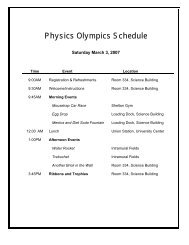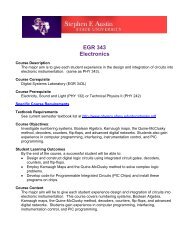Program - Physics & Astronomy - Stephen F. Austin State University
Program - Physics & Astronomy - Stephen F. Austin State University
Program - Physics & Astronomy - Stephen F. Austin State University
Create successful ePaper yourself
Turn your PDF publications into a flip-book with our unique Google optimized e-Paper software.
2:42 pm - AB-7 - Preservation of Non-Classicality in theContinuous-Variable Quantum Teleportation, FuLi Li,flli@physics.tamu.edu, Tiegang Di, Tiegang-di@neo.tamu.edu,M. Suhail Zubairy, Department of <strong>Physics</strong> and Institute forQuantum Studies, Texas A&M <strong>University</strong>. The relation betweenthe P-functions of the input and output states in the protocol ofquantum teleportation of continuous variables of an optical fieldis established. Based on this relation, we find a conditioninvolving the squeezing parameter and the detector efficiency,under which the P-function of the output state becomes the Q-function of the input state such that any non-classical features inthe input state will be eliminated in the teleported state. Inparticular, we notice that if the homodyne detection efficiency isless than 0.5 the teleported field must be classical even if theentanglement in the quantum channel is perfect.2:54 pm - AB-8 - “Magic-Angle” Technique for Suppressionof Inhomogeneous Broadening of Mössbauer Spectra, PetrAnisimov, petr@tamu.edu, Yury Rostovtsev, OlgaKocharovskaya, Texas A&M <strong>University</strong>. In this work, wedemonstrate “magic-angle” technique with respect to Mössbauerspectroscopy. The case of dipole interaction of 57 Fe is analyzed.Floquet-state perturbation theory for the RF modulation of theMössbauer resonance and the concept of effective magnetic fieldis used to calculate the spectra of the 14.4 keV 57 Fe nucleartransition. Our analysis provides physical insight into thetechnique and defines necessary range of parameters for anexperimental realization.3:30 pm - AB-9 - Control of Ionization Rates of H2 + by SingleCycle Pulses Timed with Respect to Molecular Motion,Andrea Burzo, andrea@physics.tamu.edu, Alexei Sokolov,sokol@tamu.edu, Department of <strong>Physics</strong> and Institute forQuantum Studies, TAMU. Photo-ionization with single-cyclepulses is a first step toward studying atomic dynamics on thetime scale of electronic motion. Previous work has shown that itis possible to produce a train of identical single cycle pulses,perfectly synchronized with molecular motion and separated byan integer (4 or 9) of molecular periods. These pulse trains canbe used for studying multiphoton ionization on a fewfemtosecond timescale. If the input field frequencies are amultiple of their frequency difference, then processes ofdifferent order will interfere, leading to a complex dependenceof ions signal for different sub-cycle pulse shapes. We arestudying how the ionization probability will change as a result ofdifferent time delays between the laser pulses and molecularmotion. As a result, one can control the ionization rates byadjusting the arrival of the pulses with respect to the molecularmotion.planarity was calculated to be 247 cm -1 , slightly higher than the233 cm -1 far-infrared value. The calculated vibrationalfrequencies from DFT-B3LYP/cc-pVTZ were compared to theexperimental values for the d 0 , d 1 , d 4 , and d 8 isotopomers andseveral vibrational reassignments were made.3:54 pm - AB-11 - Debye Model of Step Wandering, HowardRichards, Howard_Richards@tamu-commerce.edu, Dept. of<strong>Physics</strong>, Texas A&M-Commerce, Amber Benson, Texas A&M-Commerce, Mississippi <strong>State</strong> <strong>University</strong>, T.L. Einstein, Dept. of<strong>Physics</strong>, <strong>University</strong> of Maryland, College Park. The stiffness ofsteps on vicinal crystal surfaces is often determined by fittingexperimental step wandering functions to a theoretical form,which is based on a harmonic approximation to the potentialexperienced by the step. This approximation is analogous to theEinstein model of solids, and it can likewise be improved by a“Debye model” in which the spatial dependence is implicitthrough the relative positions of neighboring steps. The form ofthe resulting wandering function will be presented and comparedwith numerical simulations of the terrace-step-kink model for arange of step interactions.4:06 pm - AB-12 - Principle of Least Action and GaugeCompatibility for a Charged Particle in an ElectromagneticField, Donald H. Kobe, kobe@unt.edu, <strong>University</strong> of NorthTexas. The Principle of Least Action is used for a singlenonrelativistic charged particle in an external electromagneticfield. The Hamiltonian used requires a choice of gauge for thevector and scalar potentials. The trial wave function usedrequires a choice of a space- and time-dependent phase that is agauge choice for the wave function. These two gauge choicesmay not be compatible. We generalize the original trial functionby multiplying it by an arbitrary space- and time-dependentphase factor. When this generalized wave function is used in theprinciple of least action and the action is varied with respect tothe phase, we obtain an equation of continuity. From thisequation of continuity we can determine the new phase that iscompatible with the gauge of the Hamiltonian. Equivalently, wecan determine a new gauge for the potentials in the Hamiltonianthat is compatible with the gauge of the original wave function.We apply the method to a charge particle in the electric dipoleapproximation with a real trial wave function and a Hamiltonianin the Coulomb gauge. For a real trial wave function, theHamiltonian must have new potentials that are in the electricfield gauge. For a Hamiltonian in the Coulomb gauge, the phaseof the trial wave function is determined. When the Hamiltonianis time independent and the trial wave function has only timedependence Et in its phase, the principle of least action reducesto the energy variational principle.3:42 pm - AB-10 - Ab Initio Calculations for the Structure, 4:18 pm - AB-13 - On the Physical Origin of the Earth'sVibrational Frequencies, and Barrier to Planarity of Electric Field, Wayne M. Saslow, wsaslow@tamu.edu, TexasCyclopentene, Abdulaziz Al-Saadi, alsaadi@mail.chem.tamu.edu,A&M <strong>University</strong>. Although the earth's atmosphere is by noJaan Laane, means in equilibrium, it does have certain steady-statelaane@mail.chem.tamu.edu, Department of Chemistry, Texas properties. This leads one to hope that these properties may beA&M <strong>University</strong>, College Station, TX 77843-3255. Ab initio and described in the language of irreversible thermodynamics. TheDFT calculations have been carried out for the cyclopentene physical origin of the earth's electric field then may reside in amolecule in order to analyze its structure and vibrational thermoelectric effect between the atmosphere and the earth'sfrequencies. The structure was calculated with MP2/6- surface, although other disequilibria besides temperature311++G** and MP2/cc-pVTZ basis sets and these predicted (pressure, electrochemical potentials of certain constituents ofpuckering angles of 27.1° and 26.1°, respectively, as compared the atmosphere) could also be responsible for the earth's electricto the experimental far-infrared value of 26°. The barrier to field. Lightning then appears as a discharge phenomenon26


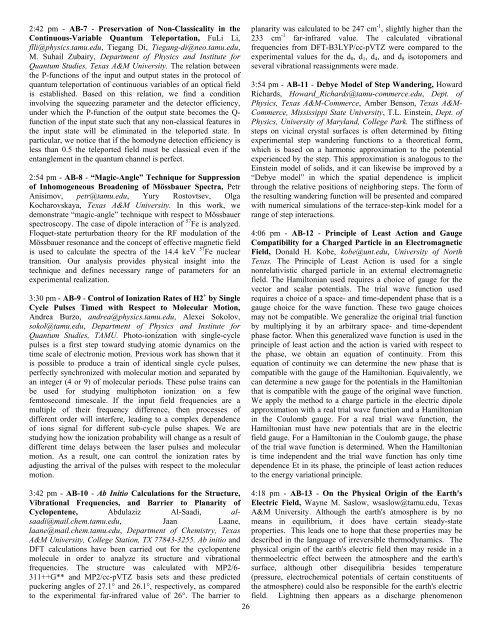

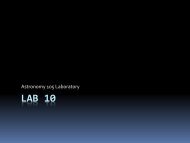
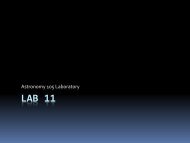
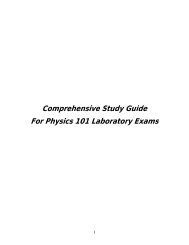

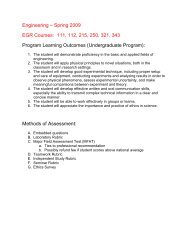
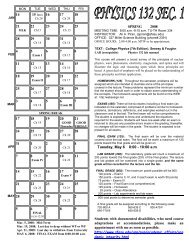
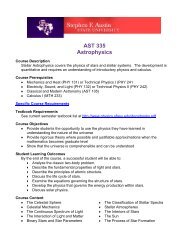

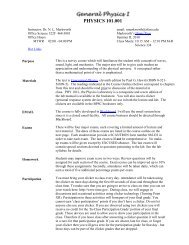
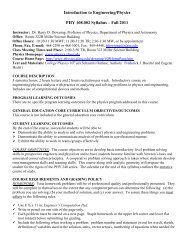
![[pdf] physics 110 fundamentals of electronics](https://img.yumpu.com/29312006/1/190x245/pdf-physics-110-fundamentals-of-electronics.jpg?quality=85)
